Fun fact. American consumers will pay 17% more to purchase from a company with a reputation of delivering a great customer experience. In fact, this trend has made quite an impact on US ecommerce companies in recent years as it has led organisations to adopt feedback strategies in hopes of achieving this status.
With feedback at the core of our business, Mopinion is always interested in seeing how organisations in today’s market work with feedback and tie these insights into their digital strategy. In this article, we examined the feedback efforts of three top performing ecommerce companies in the US, with the intention of gaining a better understanding of the current state of feedback in the US ecommerce market as well as identifying what’s on the menu for the coming years.
Second only to China, the United States is one of the largest ecommerce markets in the world. With total online sales hitting nearly US $768 billion (in 2021) which is up 17.9% YoY (year-on-year), the US market claims nearly 15% of the ecommerce market share worldwide; numbers which will undoubtedly grow in the coming years.
The Effects of COVID and Mobile Accessibility
The recent acceleration in growth and sales in the ecommerce market can be attributed to the two factors: the COVID pandemic and the infiltration of mobile technology into the lives of American consumers.
Since the start of the COVID pandemic, many consumers both in the US and around the world began changing their shopping behaviour. To illustrate, at the beginning of last year (2021), nearly 85% of American consumers reported that the crisis had impacted their shopping habits. As a result, we saw a boost in online shopping and use of home delivery and a decrease in convenience store shopping.
Additionally, mobile apps have since taken hold of the market. Their grip is so tight, in fact, that more than half of consumers (55%) use mobile apps for their online shopping; a trend which highlights the importance of providing not only a good website customer experience, but also an exceptional mobile experience.
This dominance in the market is why we thought we’d investigate some top ecommerce companies and find out firstly what varieties of feedback they collect. We also wanted to search for gaps in their websites, and, finally, we wanted to suggest some ways for these ecommerce giants to improve and capitalise on their website traffic.
Status Quo: Ecommerce in the US
Let’s take a look at some of the top ecommerce companies in the US and see how they currently collect customer feedback.
1. Amazon
As the world’s largest ecommerce company, Amazon has been quite the trend setter in the ecommerce world. For over twenty years, the organisation has prided itself in not only its excellent product inventory and competitive pricing, but also it’s unrivaled customer experience both online and offline.
For most Amazon users, the first thing that pops into your head is probably the delivery services. Same day delivery, Amazon lockers or even those drones that deliver your products to your front doorstep. It’s groundbreaking stuff, really. But what about everything that’s happening online?
As a top-tier company that is known for delivering a superior customer experience, how exactly do they conduct their feedback program? To find out, we dug a little deeper.
Unsurprisingly, Amazon offers its customers a number of options for providing feedback. One of the most common, however, is post-purchase product feedback which is sent out via email. See example below.
Here you can rate the product you purchased using a 1-5 star scale.

Additionally, you can provide a product review via the Order Details page in the MyAccount section:

In which case you would fill in a form that looks like this:
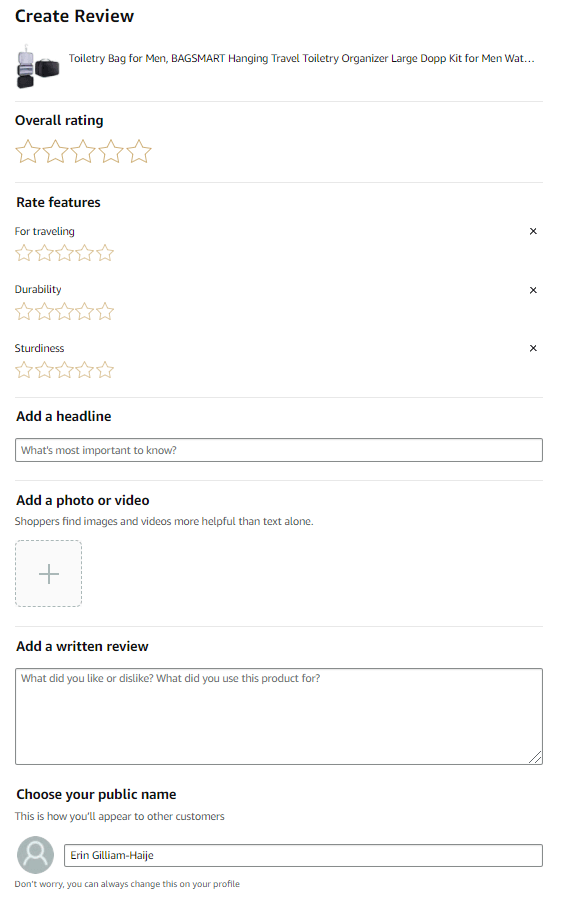
Amazon also puts a heavy focus on seller feedback, which is gathered using email feedback surveys like the one below.
Here the customer can – just like the product feedback option – rate the seller with a feedback form using a 1-5 star scale.
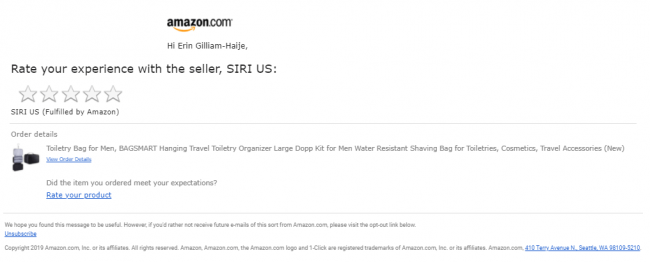
If you’re looking to leave some feedback on the Amazon website in general, about some issues at the checkout, for example, they have a full list of FAQs to help answer a host of issues. But, if this fails, then you can use the chatbot to help you solve any issues in real time. Note: while available the chat function is somewhat difficult to locate on the website. It’s listed under customer service in the left hand sidebar.
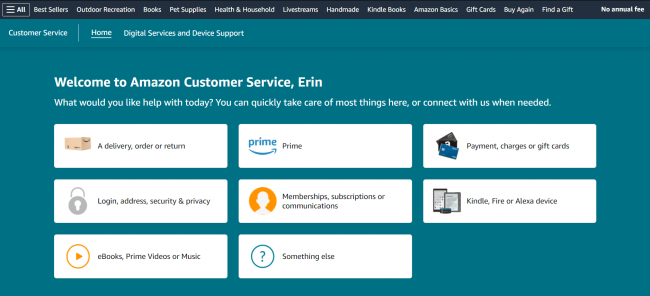
2. Walmart
And then we have Walmart, the number two ecommerce company in the US. With nearly 14% of the retail market, Walmart has been taking some serious steps to keep up with the digital transformation. According to RIS News, the organisation has upped its game with new technologies that enable them to offer seamless pickup and delivery of online purchases. Walmart has also launched new features across web and app to boost customer experience, including new search functionalities for Walmart Auto Care.
So how does this ecommerce giant collect feedback, you ask? Let’s take a look.
One simplistic yet effective approach Walmart uses is its web feedback option at the bottom of the homepage. Users can provide feedback using the generic web survey below.

Additionally, customers can provide post-purchase feedback (via email) regarding their purchasing experience.
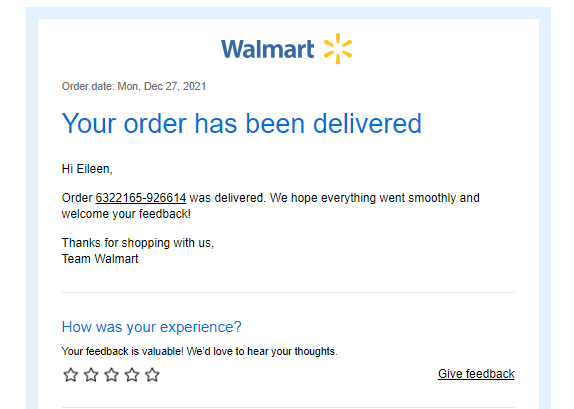
And another example:
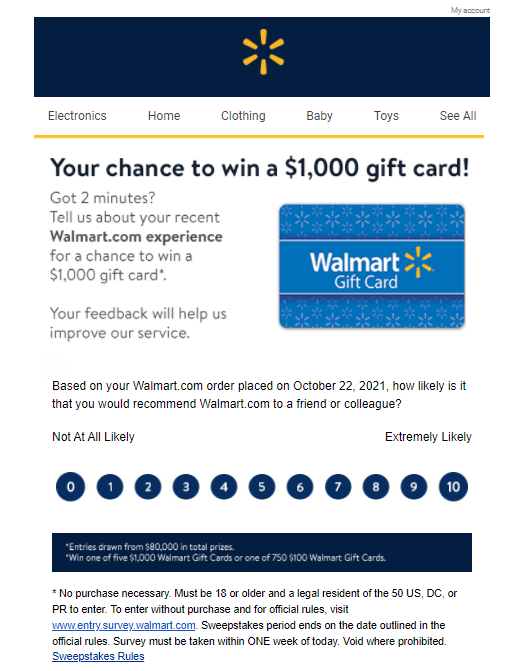
Walmart also gathers customer experience feedback via email surveys. However, it is unclear how frequently these surveys are deployed or what the recipient criteria is.

As for the chatbot option, they are currently in the trial process.
3. Target
And lastly, we have Target. Target is a very well-known, leading American ecommerce company that offers everything from groceries and essentials to clothing and electronics. When talking about Target, many shoppers refer to the ‘Target Effect’, which is the experience whereby shoppers come to Target for one thing and end up buying a whole bunch of other items they didn’t think they ‘needed’ (sounds familiar, right?). However, this is mainly an in-store phenomenon.
So how does Target cater to and retain its customers in an online environment?
Target actually has quite a few places on its website where it requests feedback. For example, webpages with a lot of information (i.e. FAQs or the Target Circle rewards program page), product pages, and even the reviews on product pages themselves.
Let us illustrate…
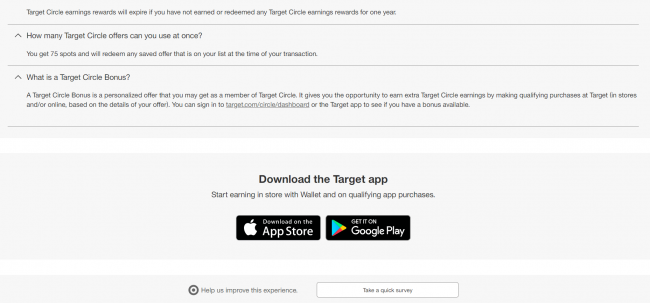
Target FAQ page (on Target Circle)
When you click on this survey button, the following survey pops up.

And here’s an example of feedback on the product pages:
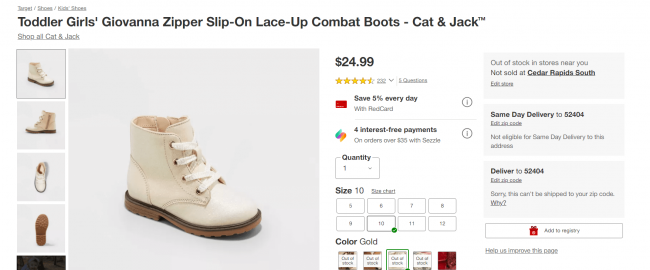
And how it looks when you open the survey:
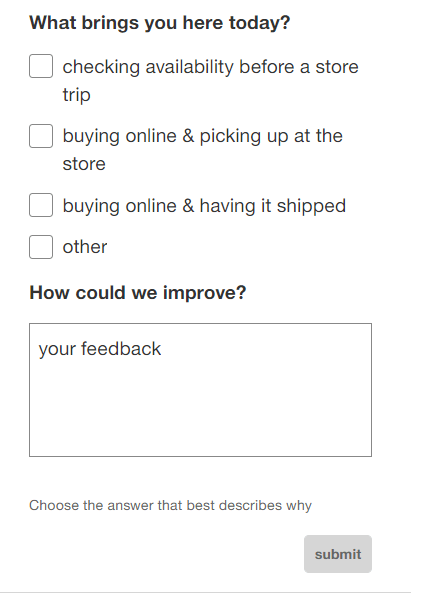
Additionally, customers have the opportunity to comment on reviews listed at the bottom of product pages.

Target also collects feedback via email. For example, Target Circle users occasionally receive Net Promoter Score (NPS) email surveys.

Target also offers a chatbot which is located in the Help section at the bottom of the homepage.

Free White Paper: Boost your retail website with online feedback
Learn how user feedback can aid in maintaining a sound customer experience.
Key Takeaways
Product reviews are imperative
Similar to the UK market, product reviews are a favorite among ecommerce companies in the US. This doesn’t come as a surprise, though, seeing as how – according to PowerReviews – 98% of consumers feel that reviews are an essential resource when making purchase decisions, up from 89% in 2018.
Among these three ecommerce companies, requests for product reviews are readily available in various locations including individual product pages and within post-purchase email campaigns.
Bottom line: in a world where customers are not getting the physical experience of products before purchasing, this remains a critical type of feedback for ecommerce players.
No shying away from email surveys
Another trend we noticed in our research is that these ecommerce giants are not afraid to survey their customers by email. In fact, email surveys seem to be their most common way of gathering feedback (especially product feedback) from customers.

Best Practices for Collecting Email Feedback in Retail
Discover why email feedback is important for the ecommerce industry and how your business can use it effectively
For these particular organisations, they are used to gather insights into the product itself (post-purchase email surveys), but also to gauge loyalty among customers (surveys using NPS). What was also interesting is that Walmart uses email surveys to gather feedback on the customer experience specifically; an interesting approach which could also be applied to surveys on the website, but we’ll get to that in the section below…
What’s missing?
After investigating these three ecommerce companies, we’ve come to some interesting conclusions.
Perhaps one of the most palpable shortcomings is the absence of feedback surveys across the entire customer journey. We see lots of product feedback and post-purchase surveying going on, but there don’t seem to be any feedback opportunities for customers while they’re still in the funnel. For example, feedback surveys that can help gauge why a customer abandons their shopping cart or ‘active’ surveys that measure on-page experiences in the moment.
That being said, here are a few ways in which these US ecommerce market leaders can collect useful insights through customer feedback.
Collecting feedback in the moment
Gathering feedback in the moment and throughout the customer journey is critical. Not only will it provide the organisation with the means to directly optimise funnels but also improve the customer experience as a whole.
For example, organisations can gather what is referred to as ‘exit feedback’. This is a feedback survey that is only triggered when your visitors intend to exit the website, i.e. moving the cursor towards the ‘x’ button or the URL bar. In other words, when it looks like the visitor intends to leave the point of conversion. This could be when the visitor leaves the website entirely or leaves in the middle of the payment process and goes to another part of the website instead of completing the order. The feedback gathered in these moments will provide insight into why the customer is leaving the page or what is preventing them from reaching their online goal.
And part of attaining this feedback is knowing how to ask the right questions, at the right time. In other words, a smart question routing strategy is key. With a more in-depth understanding of your customers’ pain points, you’ll be better equipped with the knowledge to improve those areas.
In order to come up with valid ideas that move the site forward, I believe 80% of the effort is simply to listen to your customers. They talk to you through their actions, interactions, engagements and other data they leave behind.
Davy Schuyt, CRO Manager at Calvin Klein
Check out the customer story to find out more about how Calvin Klein uses Mopinion to deliver a seamless experience for their customers.
Mopinion offers a wide array of targeting options so that your timing is always right, and our product offers a good deal of feedback survey templates, so you can always ask the right questions, at the right time.
Making it more human with conversational feedback
Additionally, we noticed another underused method of feedback collection among these retailers: chatbots, or conversational AI. Many US retailers either didn’t offer a chatbot at all or it was tricky to find as it was buried deep on the website. Conversational AI allows businesses to have two-way communication with the customer. Not only are businesses able to answer queries and issues faster, but the AI can also learn and build a relationship with the consumer. The advantage is clearly there, as stores using conversational AI in the right way are increasing annual revenue by 7 to 25%.
Did you know? Conversational feedback is a relatively new-to-market approach to conversational marketing. This type of feedback allows organisations to collect feedback in a way that is casual, fun and personal, allowing customers to really open up. The result? Increased response rates and even richer insights.
Learn more about how you can leverage conversational feedback with Mopinion here.
Time to get crackin’, retailers!
By now it’s probably clear that gathering customer feedback is one of the best ways to find out why your customers are dropping off which is a critical insight in the world of ecommerce.
Want to find out how Mopinion helps retailers like Calvin Klein and Sportscheck to increase conversion rates? Book a demo or try our free trial to find out what your online visitors and customers really expect from you.
Are you eager to read more about feedback in connection with ecommerce? Then visit our blog, full of handy tips and tricks on how to optimise your online shop at all stages of the customer journey.
Ready to see Mopinion in action?
Want to learn more about Mopinion’s all-in-1 user feedback platform? Don’t be shy and take our software for a spin! Do you prefer it a bit more personal? Just book a demo. One of our feedback pro’s will guide you through the software and answer any questions you may have.







